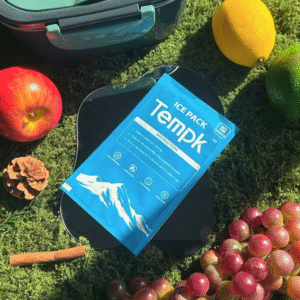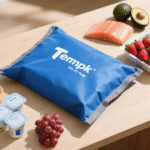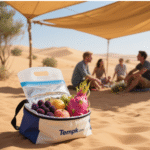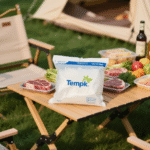A local dry ice pack isn’t just a block of frozen carbon dioxide; it’s a reliable tool for preserving the quality of frozen and temperature sensitive items during shipping. In this guide you’ll learn how these ultra cold packs work, why they’re useful for local deliveries and long distance logistics, and how to handle them safely. Trockeneis bleibt bei –78,5 °C (–109,3 °F) and sublimates directly from solid to gas, eliminating the mess of melted water. This makes it ideal for transporting vaccines, frozen foods and lab specimens without leaks or bacterial growth. You’ll also see how much dry ice you need for different transit times, how it compares with gel packs and phase change materials, and what innovations to expect in 2025.

What exactly is a local dry ice pack and how does it work? Learn the basics of dry ice physics and packaging, including why it stays cold without melting.
How to choose the right dry ice pack for food, pharmaceuticals or lab specimens? Explore sizing rules, safety precautions and recommended quantities.
Trockeneis vs. Gelpacks vs. PCM: Understand the pros and cons of different cooling agents, including regulatory and sustainability considerations.
Best practices for packing and shipping with dry ice: Follow safety guidelines for ventilation, labeling and handling.
2025 innovations and trends: Discover new materials, smart sensors and market insights that will shape cold chain logistics.
What Is a Local Dry Ice Pack and How Does It Work?
Dry ice is simply carbon dioxide in solid form. Im Gegensatz zu Wassereis, it does not melt into a liquid; instead it sublimates directly into CO₂ gas when warmed. This property creates a consistently low temperature environment without leaving moisture, which is why dry ice is preferred for shipping perishable goods. Local dry ice packs are packaged pieces of dry ice—often encased in heavy duty plastic or non woven textile layers—that can be purchased from local suppliers for immediate use. These packs maintain temperatures around –78.5 °C and are available in blocks, Platten, pellets or sheets.
Dry ice provides several advantages over conventional ice:
Kein Rest: Because it sublimates directly to gas, dry ice leaves no water that could damage packaging or products.
Leicht: Dry ice is lighter than regular ice, reducing shipping weight and costs.
Längere Kühldauer: Dry ice maintains cold temperatures longer than water ice, especially when insulated.
Hygienisch: It does not support bacterial growth, mold or mildew because there is no moisture.
In a local context—such as within a city or regional area—dry ice packs are often used by meal kit services, seafood distributors, vaccine clinics and laboratories to maintain product integrity during same day or overnight shipping. Many local suppliers manufacture dry ice daily to ensure maximum cooling power and deliver packs directly to businesses.
How Sublimation Helps Cold Chain Logistics
Sublimation is the process where a solid turns directly into a gas without becoming a liquid. Dry ice’s sublimation absorbs a large amount of heat, which keeps nearby products frozen. Als Trockeneis untermauert, it displaces oxygen with carbon dioxide, slowing down spoilage and inhibiting bacterial growth. Zum Beispiel, frozen seafood shipped with dry ice stays below –20 °C to maintain texture and taste; oxygen displacement prevents oxidation and spoilage.
| Besonderheit | Funktion | Nutzen | What It Means for You |
| Ultra cold core (–78,5 °C) | Keeps payloads below freezing | Longer preservation times | Suitable for vaccines, biologics and frozen foods |
| Sublimation (Keine Flüssigkeit) | Festes CO₂ wird zu Gas, leaving no moisture | Reduces contamination and packaging damage | Cleaner shipping and easier disposal |
| Durable outer layers | Multi layer materials resist punctures and regulate gas release | Prevents leaks during handling | Lower risk of product damage |
| Lightweight design | Lower density than water ice | Saves space and freight costs | More goods per shipment, lower shipping bills |
| Customizable shapes | Available as blocks, pellets or sheets | Fits various containers | Flexibility for parcels, pallets and clinical kits |
Practical Tips and Advice
Use heavy duty packs for frozen goods: For shipments requiring temperatures below –10 °C—such as ice cream or biological samples—choose heavy duty dry ice packs. These packs last longer and keep goods ultra cold.
Opt for local supply: Purchasing dry ice packs from a local manufacturer ensures fresher ice with slower sublimation rates. It also reduces CO₂ emissions associated with transport.
Combine with insulation: To maximize efficiency, pair dry ice packs with insulated containers or liners. Reduce empty space in the box to slow sublimation.
Monitor your shipment: For sensitive cargo, consider using temperature loggers or sensors integrated into modern packs to track conditions in real time.
Beispiel aus der Praxis: A catering business delivering frozen appetizers across town used locally sourced dry ice packs along with insulated bags. By filling empty spaces with crumpled paper and adding 5 kg Trockeneis (approximate weight for overnight shipping), they maintained product quality and avoided any soggy packaging.
How to Choose the Right Local Dry Ice Pack for Different Applications?
Choosing the correct pack involves considering shipment size, Dauer, product sensitivity and regulatory requirements. Here are key questions and guidelines.
- What’s the weight and transit time?According to the UO shipping guide, shipments generally require 5–10 pounds (2.27–4.54 kg) von Trockeneis pro 24 Std.. Für längere Dauer, a rule of thumb is:
Über Nacht (≤ 24 Std.): Pack half the payload weight in dry ice.
48 Std.: Use equal weight of dry ice and payload.
72 Stunden oder mehr: Verwenden 1.5 times the payload weight.
- What temperature range does your product need?Heavy duty dry ice packs maintain below –70 °C and are ideal for vaccines and deep frozen goods. Gel packs and phase change materials (PCMs) are better for chilled products between 0 °C und 8 °C.
- How sensitive is your product to freezing?Use gel packs for items that must not freeze, like fresh produce or chocolates. For biologics or enzymes requiring ultra cold conditions, Wählen Sie Trockeneisbeutel.
- What are your regulatory obligations?Trockeneis wird als klassifiziert als Gefahrgut (UN1845). Packages containing more than 2.5 kg (5.5 lb) of dry ice must follow PHMSA and IATA guidelines for labeling, venting and documentation. If you need to avoid hazardous material paperwork, consider non hazardous PCMs or gel packs.
- Do you prioritize sustainability?Dry ice sublimates without leaving physical waste but its production releases CO₂. Some suppliers capture industrial CO₂ to produce dry ice. Gel packs and PCMs can be reusable and have biodegradable exteriors. Balance environmental impact with performance when selecting a pack.
Choosing Dry Ice Pack Size and Quantity
Dry ice quantity affects how long your product stays frozen. Here’s a simple reference table:
| Shipment Duration | Recommended Dry Ice | Beispiel (10 lb Payload) | What It Means for You |
| 24 Std. (über Nacht) | 0.5 × Nutzlastgewicht | ~5 lb dry ice | Ideal for local deliveries or next day courier service |
| 48 Std. | 1 × Nutzlastgewicht | ~10 lb dry ice | Suitable for regional or cross country shipments |
| 72 Stunden+ | 1.5 × Nutzlastgewicht | ~15 lb dry ice | Required for long distance or international shipping |
Application Specific Tips
Essen und Getränk: For frozen meats, seafood and desserts, maintain temperatures below –20 °C. Use heavy duty dry ice packs and insulate the box. For chilled items like cheese or fresh produce, gel packs or PCMs are preferred.
Pharmaceuticals and biotechnology: Vaccines and biologics often require ultra cold conditions. During the COVID 19 pandemic, the Pfizer BioNTech vaccine needed storage below –70 °C, making dry ice indispensable.
Laboratory specimens: Blut, tissue and diagnostic samples must remain frozen; dry ice packs preserve integrity during transit.
E commerce meal kits: A mix of dry ice and gel packs can create multiple temperature zones—one side for frozen ingredients and the other for chilled produce.
Tatsächlicher Fall: A seafood distributor switched from gel packs to heavy duty dry ice packs for cross country deliveries. By using an equal weight of dry ice and payload for 48 hour transit, Sie reduced spoilage from 12 % Zu 1 % and saved over $50,000 jährlich. The moisture free packaging also decreased customer complaints about soggy boxes.
Dry Ice vs Gel Packs vs Phase Change Materials: Welches ist am besten?
When deciding between cooling methods, Berücksichtigen Sie den Temperaturbereich, hazard classification, reusability and typical use cases. The Tempk guide provides a comparison:
| Kühlmethode | Temperaturbereich | Hazard Classification | Wiederverwendbarkeit | Typical Use Cases |
| Trockeneisbeutel | < –70 °C | Gefährlich (UN1845); requires labeling | Einmalgebrauch; can combine with gel packs | Deep frozen biologics, gefrorenes Fleisch, Eiscreme |
| Gelpackung | 0 ° C bis 8 °C | Ungefährlich | Single use or limited reuse | Vaccines that must not freeze, Schokolade, frische Produkte |
| PCM-Paket | 2 ° C bis 8 °C oder –20 °C | Ungefährlich | Wiederverwendbar | Pharmazeutika, clinical trials, extended durations |
Key differences:
Temperaturregelung: Dry ice provides ultra low temperatures suitable for deep freezing, while gel packs keep goods chilled near 0 °C. PCMs maintain specific ranges (Z.B., 2–8 ° C) and can be tailored.
Regulatorische Anforderungen: Dry ice is classified as hazardous and requires labeling and documentation. Gel packs and PCMs are easier to ship because they’re non hazardous.
Feuchtigkeit: Gel packs melt into water, requiring moisture protection and potentially causing soggy packaging. Trockeneis untermauert in Gas, leaving packaging dry.
Umweltauswirkungen: Dry ice sublimation releases CO₂, whereas gel packs and PCMs can be reused. Biodegradable gel pack exteriors and CO₂ capture technologies are emerging.
Empfehlungen
Gefrorene Sendungen (>72 Std.): Use heavy duty dry ice packs. Combine them with gel packs to slow sublimation and extend cooling.
Gekühlte Sendungen (0–8 ° C): Choose gel packs. They are cost effective and non hazardous.
Moderate cold or reusable needs: PCMs are ideal for pharmaceuticals and clinical trials where reusability and precise temperature control matter.
Practical pointer: If you ship chocolates that must not freeze, avoid dry ice. Stattdessen, use a gel pack and insulated box to maintain temperatures between 4 °C und 8 °C. Für gemischte Sendungen, separate frozen items with a barrier and place dry ice only around them.
Safety and Regulatory Considerations
Because dry ice sublimates into CO₂ gas and reaches extremely low temperatures, it poses several hazards:
Explosion hazard: Als Trockeneis untermauert, it releases large volumes of gas; if packaged in a sealed container, pressure can build up and cause an explosion.
Suffocation hazard: CO₂ can displace oxygen in confined spaces; high concentrations can cause asphyxiation.
Erfrierung: Direct contact with dry ice can cause severe skin burns.
Regulations for Packaging and Labeling
Dry ice shipments must comply with U.S. Verkehrsministerium (PUNKT) and International Air Transport Association (Iata) Regeln. The UO guide outlines these requirements:
Gas venting: Packages must allow CO₂ gas to vent. Trockeneis in luftdichten Behältern nicht versiegeln, jars or plastic bags.
Package strength: The container must withstand normal loading and unloading and prevent loss of contents.
Materialauswahl: Avoid plastics that become brittle at low temperatures; use containers designed for dry ice.
Beschriftung: Mark packages with “Dry Ice” or “Carbon Dioxide, Solide,” the UN number (UN1845) and net weight in kilograms. Place hazard class 9 labels on vertical sides.
Quantity limits: The maximum allowable dry ice per package is 200 kg. Carriers often exempt shipments containing 2.5 kg (5.5 lb) or less from certain hazardous material regulations.
Handling and Storage Tips
Wear protective gear: Use insulated gloves and eye protection to avoid frostbite.
Belüftung sicherstellen: Store and transport dry ice in well ventilated areas to prevent CO₂ buildup. Do not store in confined spaces such as car trunks for extended periods.
Avoid freezers and airtight coolers: Do not store dry ice in standard freezers or airtight containers; gas buildup can damage equipment or cause explosions.
Limit pickup quantities: Dry ice sublimates at roughly 5 Zu 10 Pfund alle 24 Std.. Purchase it close to the time of use and do not exceed institution specified limits (Z.B., 25 lb at Florida International University).
Verantwortungsbewusst entsorgen: Let remaining dry ice evaporate in an open, gut belüfteter Bereich. Never throw it into drains or trash cans.
Sicherheitsnotiz: A university lab scheduled dry ice shipments during cooler evening hours to minimize sublimation. They used insulated gloves and labelled packages with UN1845 and net weight. Because they allowed venting and avoided airtight containers, there were no pressure related accidents.
Practical Packing and Shipping Guide
Step by Step Instructions
Calculate the required dry ice: Determine the payload weight and desired shipping duration. Use the rule of 5–10 pounds per 24 hours and adjust for overnight (0.5 × Nutzlast), 48 Std. (1 × Nutzlast) oder länger (1.5 × Nutzlast).
Prepare the container: Select an insulated cooler or Styrofoam box that allows gas to vent. Line it with moisture barrier bags if shipping food.
Package the product: Place the product in sealed bags or vacuum sealed pouches to prevent freezer burn. Cushion fragile items with cardboard or foam.
Add dry ice packs: Place dry ice packs on top of or around the payload. Avoid direct contact between dry ice and items that should not freeze. Fill empty space with packing peanuts or paper to reduce air volume.
Close and seal: Close the container securely with tape, but ensure there’s a vent or small gap for CO₂ release. Do not use airtight plastic boxes.
Label and document: Affix hazard class 9 labels and write “UN1845, Trockeneis, X kg” on the box and the air waybill. Record shipper and consignee information.
Ship promptly: Arrange delivery to ensure the recipient is available. Consider local holidays and closures.
Ventilation and Transportation
Beim Transport von Trockeneis in einem Fahrzeug, keep windows slightly open for fresh air and avoid staying inside a closed cabin for more than 15 Minuten. Secure the container to prevent movement as the dry ice sublimates, which could shift the weight and damage products. Never transport dry ice in the passenger compartment if the vehicle has limited ventilation.
Lab scenario: A biotech company shipped a batch of enzyme samples across the state. Sie benutzten 5 lb of dry ice for a 24 hour trip and vented the container by slightly loosening the lid. The driver kept the car windows open and made sure the package was secured. The samples arrived fully frozen and the driver experienced no asphyxiation symptoms.
2025 Trends and Developments in Dry Ice Pack Technology
Technological Innovations
In 2025 the cold chain industry is embracing smart and sustainable solutions. Smart sensors and IoT devices are now being embedded into dry ice packs to track temperature, humidity and sublimation rates in real time. These sensors send alerts when cargo warms above critical limits, allowing shippers to intervene before product integrity is compromised.
Hybrid configurations are gaining popularity. According to Mercury’s 2025 Bericht (as summarized by Tempk), combining PCMs with dry ice allows multi temperature zones and reduces the amount of dry ice needed. Such hybrid systems provide more stable thermal performance and minimize CO₂ emissions.
Sustainability and Materials
Sustainability remains a key trend. Packaging designers are shifting away from expanded polystyrene (EPS) toward recyclable cardboard with thermal liners. Gel packs with biodegradable exteriors and reusable PCM packs help reduce waste. While dry ice itself does not create physical waste, its production and sublimation release CO₂. To mitigate this, some suppliers capture CO₂ from industrial processes, effectively recycling greenhouse gases into dry ice. Others are developing bio based refrigerants that offer similar cooling capacity with a lower carbon footprint.
Market Growth and Demand
The global cold chain packaging market is expanding rapidly. Industry reports suggest it will exceed $32 Milliarden von 2025, fueled by e commerce grocery deliveries, pharmaceuticals and biotechnology. Growth in online grocery shopping and direct to consumer meal kits increases demand for reliable, cost effective frozen shipping. Heavy duty dry ice packs offer a scalable option for long distance shipments where mechanical refrigeration isn’t feasible. Gleichzeitig, regulators are scrutinizing CO₂ emissions and sustainability claims, prompting companies to adopt greener packaging practices.
Innovation Highlights
Embedded sensors: Temperature loggers with QR codes for traceability and real time alerts.
Hybrid PCM–dry ice systems: Combine moderate temperature PCMs with dry ice for multiple zones and lower CO₂ usage.
Recycled CO₂ dry ice: Manufacturing dry ice from captured CO₂ to reduce environmental impact.
Intelligente Verpackungen: Packaging that communicates with logistics platforms for predictive sublimation and just in time replenishment.
Häufig gestellte Fragen
Q1: How long does a local dry ice pack last? Dry ice packs can keep goods frozen for 18–24 hours or more depending on quantity and insulation quality. Für längere Dauer, use more dry ice according to the weight guidelines above.
Q2: Can I reuse a dry ice pack? The refrigerant core sublimates completely; therefore dry ice packs are single use. Jedoch, you can reuse the insulated outer sleeve if it’s in good condition and refill it with new dry ice.
Q3: How much dry ice is safe to ship without special documentation? The PHMSA guidelines allow packages containing 2.5 kg (5.5 lb) or less of dry ice to be excepted from many hazardous material regulations. Larger quantities require proper labeling, documentation and training.
Q4: Are gel packs safer than dry ice? Gel packs are non hazardous and easier to handle. They don’t require venting or special labels, but they provide only moderate cooling and leave moisture when melted.
Q5: How do I dispose of unused dry ice? Allow unused dry ice to sublimate in a well ventilated area. Do not dispose of it in drains, trash cans or enclosed spaces, as the gas can build up and cause hazards.
Zusammenfassung und Empfehlungen
A local dry ice pack is an indispensable tool for maintaining ultra cold temperatures in the cold chain. Its sublimation keeps goods frozen without water residue and provides lightweight, long lasting cooling. When choosing a pack, consider shipment duration, product sensitivity and regulatory requirements. Follow the rule of 5–10 pounds per 24 hours and adjust the amount based on transit time. Always use ventilated containers, label packages correctly and wear protective gear.
For foods and pharmaceuticals requiring temperatures below –70 °C, heavy duty dry ice packs offer the best performance. Gel packs or PCMs are better for chilled goods that must not freeze. Stay informed about 2025 trends like smart sensors, hybrid systems and sustainable materials to optimise your cold chain operations.
Umsetzbare nächste Schritte
Bewerten Sie Ihre Versandanforderungen: Determine payload weight and required transit time to calculate how much dry ice you need.
Source locally: Partner with a local dry ice supplier to ensure fresh, high quality packs and reduce transport emissions.
Invest in insulation: Use appropriate containers and consider adding temperature loggers for sensitive shipments.
Trainiere dein Team: Ensure that staff handling dry ice understand hazard regulations and safe practices. Seek certification if shipping large quantities.
Plan for sustainability: Explore suppliers using recycled CO₂ and consider hybrid PCM–dry ice solutions to reduce environmental impact.
Über Tempk
Tempk is a leading provider of cold chain packaging solutions. We specialise in heavy duty dry ice packs, gel packs and advanced phase change materials designed to keep your goods at the right temperature throughout transit. Our products are made using durable, puncture resistant materials and are engineered for optimal sublimation control. We continuously invest in research and development to incorporate smart sensors and sustainable materials that meet 2025 Standards. With global certifications and a commitment to quality, we help you protect your products while reducing shipping costs and environmental impact.
If you’re ready to upgrade your cold chain logistics, contact us for a consultation or sample. Our specialists can help you choose the perfect combination of dry ice, gel packs or PCMs to meet your specific needs.























